Given movies and television are the great American art form, the American Revolution has been poorly served by filmmakers. Though it was one of the most significant political upheavals in history, both mediums have largely ignored the nation’s founding. Those productions that have appeared have been, well, let’s be polite and say inconsistent. Yet in even the poorest of them, scenes or dialogue are hidden away that inform or challenge. Here we rank films and TV inspired by the Revolution, give the best and worst lines or scenes, and check their historical accuracy and entertainment value, all on a 1 to 10 scale. This is not an exhaustive list and does not include musicals, documentaries, or animation.
11. The Devil’s Disciple (1959)
A film starring Sir Laurence Olivier, Burt Lancaster, and Kirk Douglas based on a play written by Irish dramatist George Bernard Shaw. What could go wrong? Unfortunately, the answer is just about everything. This should have been superb. It turned out to be almost unwatchable. Kirk Douglas chews up the scenery as Dick Dudgeon, a Revolutionary Puritan, arrested by the British after being mistaken for local minister Rev. Anthony Anderson. In contrast, Olivier, as Gen. John Burgoyne, acts as though he knows he has made a serious error and phones his part in. Olivier regarded this film as one of his biggest failures, while Shaw disliked the work so much he disowned it. It is hard not to disagree with them. The whole thing is very theatrical but in a wooden, not artistic way, with Shaw’s arch dialogue butchered by the screenplay. It replaces sarcasm with buffoonery. The sets are high school standards, and the action sequences unbelievable. There is simply no chemistry between the three stars, who appear wary of each other’s reputations. They give all the best lines to Olivier as the victim of a stupid War Office mistake, and he contributes whatever wit there is in the piece.
Best Line. General Burgoyne: “Martyrdom, it is where one achieves fame without ability.”
Worst Line. The film was trail advertised as “Come Live the lusty American adventure as it was never lived before. In the violent age of the Devils Disciple. With all its heroes, Hellions, and danger-daring women, on the battlefields of love and war.”
Historical Accuracy: 4. The costumes are over the top, and the British grenadiers look more like down-at-heel Hessians. But there is an attempt to portray the world as it would have looked in Georgian America. The outside locations clearly reveal they shot the film in the cultivated woods and gentle hills of Hertfordshire rather than the wild, untamed forests of upstate New York.
Entertainment Value: 2. Viewable only as a curiosity. That three legendary actors could have produced such tosh is one of the mysteries of filmmaking.
10. The Rebels (1979)
A 1979 made-for-television drama based on the historical novel, these three hours of hokum top the “so bad it is good” category. Starring Don Johnson, Doug McClure, and Andrew Stevens as the aforementioned “Rebel,” the great and good of thirteen colonies are paraded on to make ridiculously portentous remarks before disappearing without a trace. Washington, Adams, Franklin, Jefferson, Paine, von Steuben, and Hancock all stumble on and off to no real purpose. This is Falcon Crestset in the Revolution. A swashbuckling adventure without a swash, buckle, or even much adventure.
Best Line. Benjamin Franklin on being accused of being a womanizer: “For a man of my advanced years to even consider the pleasures of the flesh much less enjoy it is such a wonder to behold it leaves even my worst critic struck dumb with admiration.”
Worst Line. Thomas Paine: “We have it in our power to create a future beyond imagination.” John Adams (sagely): “Aye, but there is the rub Tom. Do we wish to create a future beyond imagination?” Say what?!
Historical Accuracy: 2. Laugh out loud bad. The actors all wear terrible bouffant late 1970s hair styles, and the costumes are so psychedelic and over the top, the principal actors look more like back-up singers in Prince’s group “the Revolution” than actual Revolutionaries.
Entertainment Value: 5. I have to confess I enjoyed this more than I should have. Silly as it was, you can’t help but smile when you see Tom Bosley playing Benjamin Franklin. That casting director had nerves of steel.
9. Revolution (1985)
A world-famous production company? Goldcrest. Check. One of Cinema’s best actors? Al Pacino. Check. An Oscar-winning Director? Hugh Hudson. Check. A massive $30 million budget? Check. Now then guys, let’s sit back and watch those Oscars roll in. Revolution should have been the best film on this list. It is difficult even to know where to start with this mess, but if it were a musical, it would be Cats onsteroids. It could have been so different. Kings Lynn in Norfolk looks beautiful as colonial New York, and the art direction, staging, and costumes are superb. In addition, the cinematography and lighting wouldn’t look out of place in Stanley Kubrick’s Barry Lyndon. But there it all ends. Everything else, script, plot, casting, acting, and dialogue is so bad it is genuinely painful to watch. Pacino mumbles his way incoherently through his role as the accidental Revolutionary. Natasha Kinski is unsympathetic and unbelievable as a radical feminist and Donald Sutherland has the most ridiculous British accent ever, veering between Cornish, Cockney, and Yorkshire all within the span of a sentence. There is no plot to speak of, and long before the end, I was praying for the surrender at Yorktown—and I am British.
Best Scene. What this film could have been is shown in the panoramic, beautifully choreographed battle sequences. Easily the best depictions of Revolutionary battlefield fighting there is.
Worst Scene. Natasha Kinski is reluctantly at dinner with two effete, upper-class British officers wearing more rouge and powder than contestants on Rue Pauls’s Drag Race. She skewers one of them with a ridiculous foot long hat pin atop of which is the American flag.
Historical Accuracy: 5. There is a period sense of grime and ordure about the film that is immersive. You feel you are in Revolutionary New York. But against this, we have some of the most wooden, one-dimensional characterizations ever seen. Every figure is a stereotype. There are also some crass attempts to be relevant to contemporary politics. Shot during the height of the Troubles in Northern Ireland, on the wall of a New York tavern is daubed the words “Brits go Home.” Accurate in Belfast in 1978, maybe, but not New York in 1778.
Entertainment Value: 3. If you watch the many two-minute long clips of this film available, it may impress you. Indeed, in small chunks, it is undoubtedly beautiful to view. But with the sound off. Unfortunately, the full film lasts 125 minutes, not two.
8. Drums Along the Mohawk (1939)
A massive slice of Hollywood schmaltz, this John Ford movie haunted most rainy Sunday afternoons when I was a kid. Starring Henry Fonda, the wafer-thin plot revolves around a newlywed couple surviving the depredations of Indians and Loyalists in the wilds of New York. Henry Fonda is excellent as the earnest young Patriot Gilbert Martin and is upstaged only when character actress Edna May Oliver is on screen as battle-ax Mrs. Mcklennar. John Carradine also makes an impressively sinister showing as a one-eyed Tory, Caldwell, and is not on screen nearly long enough. In fact, the strength of this movie is the ensemble cast who ham up a feeble screenplay with such gusto you can’t help be charmed. Only leading lady Claudette Colbert grates as Fonda’s simpering wife. It is worth noting the film was made just before the start of World War II but released after the fighting had broken out. Not wanting to offend the British, the film was re-cut with the word “Tory” overdubbing the original word “British” whenever a Patriot railed against the enemy.
Best Line. Reverend Rosenkrantz preaching to the villagers: “O Almighty God, hear us, we beseech Thee. First, we are thinking of Mary Walaber. She is only sixteen years old, but she is keeping company with a soldier from Fort Dayton. He’s a Massachusetts man, and Thou knowest no good can come of that.”
Worst Line. Villager: “So that’s our new flag, the thing we have been fighting for. Thirteen stripes for the colonies and thirteen stars in a circle for the Union.” Colbert: “It’s a pretty flag, isn’t it?”
Historical Accuracy: 3. Dreadful in the main. Colbert wears hair and make-up straight out of a 1939 Sears, Roebuck catalogueand her costumes are ridiculous “fancy Dress.” The only genuine Native American is outfitted as an Apache, not Iroquois, and the white actors playing the other natives “whoop” around firing flaming arrows before running headlong into grapeshot. Only the rough-hewn farm cabin looks authentic.
Entertainment Value: 6. This is a melodrama that could just as easily been set in the Wild West as the Revolution. Its appeal lies in its humor and beautiful Technicolor cinematography—a feel-good movie for classic Hollywood buffs, not Revolutionary War enthusiasts.
7. April Morning (1988)
Rarely has an actor given a finer performance in a more mediocre film. Tommy Lee Jones, as Patriot Moses Cooper, carries this production on his back until he is shot on Lexington Green in a criminally underwhelming death scene. From there on, the film is little more than a glorified reenactment video, peppered with some of the worst dialogue ever imposed on professional actors. It really should have been much better. James Lee Barrett, who wrote the Oscar-winning Civil War film Shenandoah, wrote the screenplay. It also co-stars the late, great Rip Torn, who gives his worst-ever performance spouting lines such as, “What is peace without dignity, what is peace without honor? The King’s peace is slavery.” The British are just walk-ons and what little dramatic tension there is revolves around the blossoming relationship of two young Lexington villagers. Both are so annoying and insipid I was hoping the British would arrest them for crimes against drama before setting off for Concord.
Best Line. Moses Cooper rebukes the rabble-rousing Solomon (Rip Torn): “Everybody knows Solomon’s history. He fought with the British against the French, and he fought with the French against the Indians, and he fought with the Indians against the Indians. I am not happy with what you might call the blood of such a man determining my future.”
Worst Line. Solomon (dying from a Redcoat volley): “I’ve been plucking against the tide all my life laddie. But today I am in the company of brothers. Americans.”
Historical Accuracy: 7. There are some delicate touches in this film. Paul Revere rides through the town warning “the Regulars are coming,” not the ubiquitous “British.” The production team could have easily outfitted the British soldiers in uniform scarlet but took the trouble to differentiate between grenadiers, battalion, and light infantry, all of which are uniformed accurately. Their retreat from Concord is probably the best part of the film. Lexington looks realistic, even if it isn’t, and in the main, the costumes and art direction are good.
Entertainment Value: 5. A wasted opportunity. Even now, I do not understand why they killed off Tommy Lee Jones’s character so early. Moses Cooper has the film’s best soliloquy, explaining, “until today we were all British, but are now all Americans.” His paternal annoyance mixed with pride as he teaches his son to fire his musket correctly adds depth none of the other actors imbibe their characters with. He explains, “My love is down deep where it counts because that’s where the roots are, and if I’ve been hard on you boy, it’s because I want those roots strong.” The moment the British arrive on Lexington green is genuinely thrilling, and there is palpable tension as we await “the shot heard ‘round the world.” Unfortunately, the production dies alongside Tommy Lee Jones.
6. The Patriot (2000)
For many Americans, The Patriot is the Revolution, and despite its critical mauling, its popularity remains undiminished. Most academics sneer at its numerous inaccuracies, but I am not among them. Certainly, as a work of history, it is pure twaddle, but it is also a thrilling piece of cinema, and anything that brings people to the Revolution is to be championed. The plot revolves around farmer Benjamin Martin, driven to lead the colonial militia after a sadistic British officer murders his son. Gibson’s character “the Ghost” is clearly Francis Marion, while the Loyalist dragoon leader “Tavington” is a thinly disguised Banastre Tarleton. Contrary to myth, Gibson is excellent in the role, but the best performances come from Jason Isaacs as the dashingly malevolent Tavington and Tom Wilkinson as the acerbic Lord Cornwallis.
Best Scene. “Tell me about Ohio?” Don’t let this film’s critics persuade you nothing of historical worth exists in the movie. Researching my book on Banastre Tarleton, I concluded the man was no renegade but carried out the orders of his superior, Cornwallis. Tarleton knew the consequences, and so did Cornwallis. This beautifully-acted scene sees Tavington explain he can never return to England with honor. Instead, he will remain as part of a “new Aristocracy” in an expanded British empire. “Tell me about Ohio?” is a prescient summary of what would have happened had the British been victorious.
Worst Scene. “This will all be forgotten.” Director Roland Emmerich is German. He above anybody else on the film should have been sensitive to the dangers of those who manipulate history. When Tavington burns the village church along with its trapped occupants, he turns to his shocked men and dismisses it with “This will all be forgotten.” Chilling, but the wrong war.
Historical Accuracy: 4. Apparently, a historian from the Smithsonian was on set during the shooting of this film. We can only assume he spent all his time at the craft service table. Approach this movie with your tongue very firmly in cheek as the historical inaccuracies bludgeon you from the very beginning. Most are irrelevant to our enjoyment. But two are malicious and need to be noted. According to The Patriot, slavery was practically nonexistent in South Carolina and not that bad, anyway. The few enslaved people shown are a cheerful lot, all of whom have been given their freedom. The most notorious inaccuracy depicts Tavington burning a church complete with its occupants. While the British burned Presbyterian churches as “sedition shops,” they did not behave like the Waffen SS.
Entertainment Value: 8. Well-paced, often funny, with one of the most charismatic villains in the history of cinema, this film has aged better than most on this list.
5. Turn (2014)
Lasting four seasons, this AMC miniseries is admired and loathed in equal measure. I love it. The show undoubtedly takes liberties with historical characters and will infuriate the purist. Those who come with no prior knowledge of the Culper Spy ring it is based on, however, will be immersed. Centering on a Long Island farmer, Abraham Woodhull, the saga tells of an unlikely group of spies who “turn” the tide in America’s fight for independence. The show is well-acted, and everything from the cinematography to the fonts to the costumes is outstanding. It hooked me from the moment the Queens Rangers appeared, and the costume designer had taken the trouble to portray the Loyalist regiment’s idiosyncratic uniforms correctly down to the crescent moon on the helmet. The British may have lost the war, but they act the socks off their American counterparts in this series. Burn Gorman as Major Hewlett, Angus MacFadyen as Robert Rogers, and JJ Feild as John André are all magnificent. But the star of the show is Samuel Roukin as the psychotic, cold-blooded Lt. John Simcoe. The weakest character is the central figure played by Jamie Bell, and his on-off romance with Anna Strong left me rooting for his thoroughly decent but feeble British love rival, Major Hewlett.
Best Scene. “Dandelion.” When Simcoe turns up to command men of the Queen’s Rangers for the first time, they are not impressed with the foppish looking Englishman. One of them makes the mistake of insulting him by calling him a “dandelion.” Minutes later the soldier is a corpse at Simcoe’s feet.
Worst Scene. “Andre Courts, Peggy.” Ksenia Solo, who plays Peggy Shippen, is one of the few actresses who get this character right. In every other production, Peggy is a cold-blooded, manipulative Lady Macbeth or a simpering, irrelevant socialite. Solo’s Peggy is an impressive study of a woman torn between love for André and duty to her family. Unfortunately, her dialogue includes some toe-curling lines such as, “You’re a man who makes his own fate, and I wish to be part of it.” Or when handing over a book for her slave to take to André, “let him know when he holds this book, he will be holding my heart.” Swoon.
Historical Accuracy: 5. Based on actual events, the inaccuracies in the series are too many to list, but only two annoyed me. At John André’s hanging, Peggy Shippen is shown unaccountably watching his demise from the front row. She was not in Tappan at his death. More serious was the portrayal of John Simcoe. In real life, Simcoe was one of the best British officers of the war and, far from being a psychotic killer, was an erudite, intelligent soldier who played no little part in ensuring Canada did not become an American state.
Entertainment Value: 9. This is less a study of espionage than it is of civilians finding themselves accidentally drawn into a war and doing the wrong things for the right reasons. There are some excellent subplots revolving around love and manipulation that are subtly done. The series starts slowly but keeps on getting better. Stick with it, and it will reward you.
4. Benedict Arnold: A Question of Honor (2003)
If I gave if you the choice of any actor to play your fantasy version of George Washington, how far down the list would you be before you got to Kelsey Grammer? A bizarre choice maybe, but he actually does an excellent job portraying the nation’s Founding Father in this curate’s egg of a biopic. Even better is Aidan Quinn as the traitor Arnold and Flora Montgomery as Peggy Shippen. In fact, the cast is almost universally impressive, with John Kavanagh as judge Shippen bringing to life one of the Revolution’s more peripheral figures. Only John Light as a cynical, effete, social-climbing John André fails to convince. That’s the good. The bad is the at times dreadful dialogue filled with twentieth-century phrasing and the compression of factual events. There were clearly budget constraints in the production, and rural Ireland has to fill in for Quebec, New York, Philadelphia, and London.
Best Line. Arnold to Lord Lauderdale when he refuses to fire at “the hero of Saratoga” during a duel: “We have given this ungrateful nation three of our sons. All I have left is my reputation. I insist that you fire sir.” Lauderdale deliberately fires wide. Arnold: “Am I not worth an ounce of lead?”
Worst Line. Arnold to Peggy on first meeting: “My leg wound is but a scratch compared to that which Cupid inflicted upon my heart the moment I beheld your incomparable countenance.”
Historical Accuracy: 7. The production makes the most of Ireland’s elegant Georgian buildings. The costumes and sets are also mostly accurate, and if you squint hard enough, you can imagine yourself in colonial America. The problems stem from the truncation of Arnold’s career. His complex personality is inevitably summarized, and it depicts him as a raving madman. Running amok with a tomahawk at Saratoga, he jumps into the Balcarres redoubt and finishes at least half of the British army single handedly before falling foul to a shot in the leg. In fact, Arnold was on horseback and nowhere near the British works. He is then handed cringe-worthy dialogue in his courting of Peggy Shippen more suited to a drunk teenager at the office Christmas party. The snowy siege of Quebec apparently took place in an Irish meadow, and there are far too many other inaccuracies both important and trivial to list. But all this is forgivable, as they never detract from Quinn’s bravura performance.
Entertainment Value: 8. Approach this as a melodramatic love story, and you will thoroughly enjoy it. Just don’t go expecting more than an outline of Arnold’s career or expect too much regarding the political machinations against George Washington or the British against West Point.
3. The Crossing (2000)
Based on the novel of the same name by Howard Fast, this is the most underrated film on the list. Starring Jeff Daniels as George Washington, it centers on the desperate crossing of the Delaware and the battle of Trenton. The cinematography is excellent, as are the supporting cast. The screenplay sparkles with wit and insight and uniquely for a Revolutionary war film, Daniels’ portrayal of Washington is not afraid to be irreverent. His character utters more blasphemies and ribald remarks in ninety minutes than the real commander-in-chief may have in his entire life. This, however, makes his portrayal the most sympathetic to be found on film. A lifelong Socialist, Fast slips some pretty radical speeches into the mouths of the Revolutionaries that have more to do with 1970s American politics (when the original novel was written) than those of the 1770s. The producers, however, seem to have missed the nuance.
Best Line. Starving soldier: “What are you smoking?” Compatriot: “Dried cow dung.” Starving soldier: “What’s it taste like?” Compatriot: “Shit.”
Worst Line. Washington to the rotund General Henry Knox as he enters the pontoon: “Don’t swing your balls or you’llswamp the boat.”
Historical Accuracy: 7. There are some glaring errors. The battle took place in the face of a snowstorm, but here is undertaken in clear weather. The British are dressed incorrectly in uniforms out of period, and when the Rebel oarsmen are asked to sing a song crossing the Delaware, they strike up with “Sally Brown,” a sea shanty popular in the early nineteenth century, not the Revolution. Some of the best dramatic scenes also never took place, Washington’s upbraiding of Gen. Horatio Gates at dinner and his visit to the dying Hessian colonel Rall being the two most notable. But these inaccuracies never annoy or detract from the feature, and overall the film has an authentic atmosphere.
Entertainment Value: 8. Funny and informative. Well-acted and beautifully written. Deserves to be better known.
2. Mary Silliman’s War (1994)
Many will have never heard of this film, let alone seen it. A pity, as it is one of the most penetrating portraits of the Revolution available. Most productions about the war inevitably focus on great battles or grand political events. Mary Silliman’s War focuses on the tensions and injustices that result when a small community in rural Connecticut is ripped apart by civil war. It is an unusual backdrop, but what makes the piece unique is the narrative. This is told from a woman’s perspective as Mary Silliman attempts to rescue her attorney husband, condemned to death in retaliation for the proposed hanging of two Loyalists. Considerable effort has been taken to craft a convincing social portrait, and the film touches on issues of feminism, slavery, and loyalty with varying degrees of success. There are no big names in the production, few action scenes, and no contrived love interest. Instead, the intelligent and thoughtful dialogue is the star.
Best Line. Loyalist (to the incarcerated Selleck Silliman): “You made a great show of dispensing Revolutionary justice, Selleck. You tried to frighten the people into line. General Clinton means to show the citizens of Connecticut you have it all turned around. That the real traitor is one that is disloyal to the King, and you are the one who should hang.”
Worst Line. Rebel woman handing a musket to a black slave who has unaccountably volunteered to join the Connecticut Militia: “Here, show them what it means to fight for home and country.”
Historical Accuracy: 9. Excellent. Costume, dialogue, and lighting all have an authentic feel.
Entertainment Value: 7. Not for a first date, as at times, the production veers too much toward the “educational documentary,” forgetting it is a piece of entertainment. The scholarship, however, never overwhelms the film. A low key, intelligent film, with a unique perspective, Mary Silliman’s War is for purists with a note-pad rather than movie buffs with a popcorn bucket.
1. John Adams (2008)
Based on the Pulitzer Prize-winning biography by David McCullough, this compelling miniseries proves you do not have to dumb down history to make it popular. Filmmakers have been far too reverential about Washington, Franklin, and Jefferson. John Adams works so well through being set around one of the more ambiguous of the Founding Fathers. HBO could begin with a blank canvas. Starring Paul Giamatti, the production values are unsurpassed. Frigate masts loom, halyards clank, cobble stones glisten. Just as impressive is the dialogue. They give the actors lines that have an authentic eighteenth-century cadence. There is no use of modern phrasing such as “O.K.,” “keep a low profile,” or “our lot always gets shafted,” as in some other dramas listed.
Best Scene. Adams’s royal audience with George III. This is a precise, poetic, heartbreaking scene, even more impressive for being a verbatim portrayal of the actual exchange. Watch the brilliant Tom Hollander convey the monarch’s angst, despair, and acceptance without uttering a single word as Adams makes his address.
Worst Scene. Is there one?
Historical Accuracy: 9. Though in a series this long there are bound to be inaccuracies, it is unlikely a television history will ever be this authentic again. Scene after scene thrilled. Among my favorite was a customs agent being tarred and feathered in Boston Harbor as a mob tears off his clothes and rides him out of town on a rail. It brought home how this too-often humorously portrayed punishment must have been excruciating in real life.
Entertainment Value: 9. Some newspapers including the Los Angeles Times and New York Times criticized it for being dull and overlong. Welcome to the twitter generation.




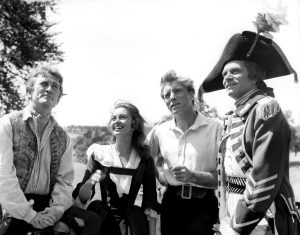


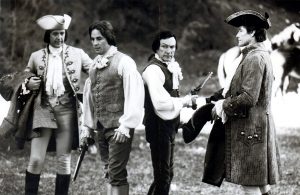
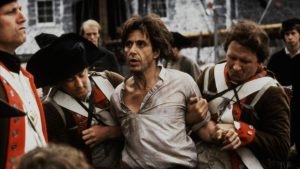
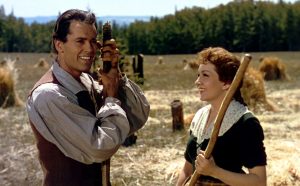
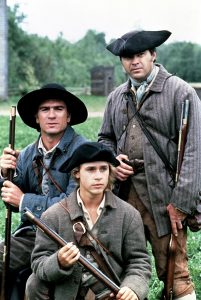


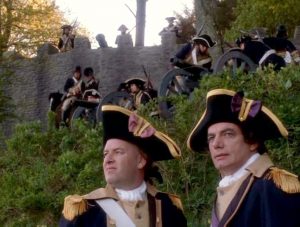
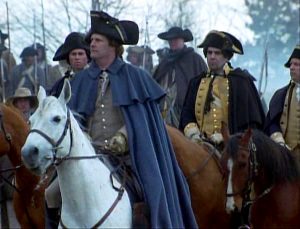

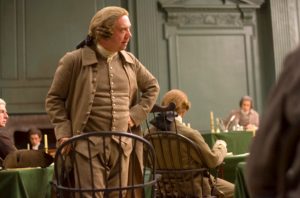




39 Comments
I re-watched the The Crossing a few months ago and continue to hold the belief that Jeff Daniels is the best George Washington on television or film, blasphemies and ribald comments notwithstanding. I think we do need to downgrade the accuracy of the movie–probably because it stayed true to the novel–more than you have it, simply by the featured presence of Alexander Hamilton as Washington’s intrepid aide throughout the film. (Hamilton won’t appear in that role until the winter 1777 encampment at Morristown.)
While I agree that Jeff Daniels did a good job with Washington, it’s still hard for me to see him in that role after watching him in Dumb and Dumber. My favorite Washington by far was Ian Kahn in Turn. I think he did an excellent job in showing Washington’s control at some points, his temper at other points, and his political prowess when needed.
I definitely agree. Ian Kahn did a fantastic job of portraying the wisdom of Washington as well as the pressure of full command.
I am totally in on “Adams” as number 1, but I put “Turn,” exactly for the reasons given of its look at the impact of a long war, occupation on civilians, as my number 2. And of course, as a kid, having read Johnny Tremain and loved it, the Disney movie always has a fond place in memories like the Hornblower films.
I think David Morse portrayed George Washington the best. His George was in ‘John Adams.’
Though I enjoyed Ian Kahn, in ‘Turn,’ the second time I viewed the series.
Didn’t see ‘Sons of Liberty’ in the listing. Where would it fall if included?
So glad you included Mary Sillimans War– I agree with your review and as a Rev War buff reallly enjoyed it. It is available on You Tube full length
Gary
As a former resident of Morristown I am pleased that you noticed Hamilton’s role. At Trenton Hamilton was with the artillery and did a stellar job of placing his guns and clearing the streets. Morristown site of two winter encampments and one mutiny always seems to be overlooked
HELL YES oh John Adams. I just watched it again recently and it’s just fantastic. Also, for 18th Century warfare, check out Culloden on Youtube, from 1964. It’s strange and shocking and brutal.
This was great fun, and introduced me to several films I did not know. Thank you. One nitpick — the review of “Drums Along the Mohawk” refers to the actress portraying the leading lady as Paulette Goddard, though later on it correctly refers to her as “Colbert.” In fact, it was Claudette Colbert (who was, indeed, simpering and silly in the role). [Thank you, this has been corrected—Editor]
Thanks for this listing. It will be of great benefit to teachers of all ages.
I will tell you one bad scene from John Adams. It is in the final episode, when John Trumbull is presenting his masterpiece, The Declaration of Independence, to Adams, who not only criticizes the painting, he belittles Trumbull. In the scene, Adams calls the painting a “shin piece.” That bit of ridicule came from a southern politician. Adams admired the painting, even if he had problems with its historical accuracy. Also in this scene, Trumbull is depicted as a smarmy sycophant, which is hardly true. If anything, Trumbull was too proud and too willing to tell powerful men what he really thought. Abigail Adams admired Trumbull’s skill when they met in London in the 1780s. Adams subscribed to the painting, so would have had no need to have it unveiled to him in this way. Nothing about this scene rings true and it is a smear on Trumbull, who deserves a lot better from history.
The 1960s tv show Daniel Boone is a nice glimpse at life during the revolution
Great list. I use both the first episode of TURN and THE CROSSING in my 7th grade U.S. history classroom. The children enjoy both, though the varied British accents all over the American parts in TURN are impossible for children to understand when combined with the archaic language, and I have to line out most of their dialogue. I also show a few minutes of APRIL MORNING: the Lexington scene. You are correct that as a whole, the script and acting in that (aside from Tommy Lee Jones) are execrable. I showed the full movie only one year, long ago — to pained laughter from twelve-year-olds. Another film from which I use short scenes (of Lafayette, Washington, and Arnold) that you have not included is GEORGE WASHINGTON, the 1984 miniseries.
A great idea for a list and some excellent picks. Well done, John. Here’s another vote for Gary Ecelbarger’s choice of “The Crossing” – despite its inaccuracies – being a superb movie.
And a hearty second to John Hayward’s comment about Morristown, NJ being underappreciated for its critical role in the Revolution. Honest disclosure requires me to say I was once a resident of a nearby town, Livingston, named in honor of Jersey’s Revolutionary War governor.
Off to find the Kelsey Grammer movie!
You forgot the miniseries “Sons of Liberty.”
A solid and rational analysis. I find only one exception – Gibson’s unadulterated dumpster fire a/k/a The Man Who Beat the Empire by Himself. Rating it above April Morning – just for example – is a real reach in my opinion, and April Morning isn’t overburdened with redeeming features. So many defects and so little space. I cannot get that farce of a French accent out of my head or forget the image of that flag which could have concealed an entire battalion. If these were being rated purely on entertainment value, maybe. But otherwise Patriot doesn’t even reach the “heights” of Braveheart. So I’ll give you 10 out of 11 – that’s still an “A” in my book.
Since you included TV shows, how did Walt Disney”s “The Swamp Fox” get left off this list? I’ve heard that Walt based his adaptation on Bass’s book. Perhaps the author of this list is a lot younger than I am. I can still sing the theme song from start to finish, if anyone is interested. 😉
Drums Along the Mohawk was clearly shot in California, probably east side of the Sierras near Lone Pine. There is no more feel for the scenery of upstate New York in this movie than for those movies shot in Ireland or England. However, Henry Fonda adds a bit of authenticity as a true descendant of the Fondas of the Mohawk Valley.
Actually, “Drums Along the Mohawk” was shot near Lake Payette, ID, the same area as Northwest Passage.”
Both movies did not do justice to the maples and oaks of the Eastern forests of New York Adirondacks and Vermont Green Mountains.
Mr. Knight, Thank you. Really an excellent break down and some laugh out loud bits. The image of the Smithsonian historian at the craft service table is hilarious. Kudos for being the first reviewer I’ve ever read who points out Howard Fast’s insertion of his 20th century politics. If Greene had ever suggested to Washington that they were fighting for profit I’m pretty sure we would have two stories of Washington swearing till the leaves shook.
Solid list. As for ‘John Adams,’ I have a long love/hate relationship with it. It’s certainly the best attempt at getting the historiography right, even if the accuracy wanes at times. Paul Giamatti did the part justice, as did Laura Linney portraying Abigail Adams. David Morse nailed GW, but I still hate that they inaccurately had Washington sitting in Congress in 1775 wearing a Continental uniform with his aged-white locks. I also, while understanding the need for artistic license and flexibility, did not see the point in changing how/why Adams and Jefferson rekindled their relationship in latter years. And what’s more, the show could have devoted a pivotal scene diving into the political philosophical debate they had in their correspondence. Lastly, as discussed here for a great article on tarring and feathering, historians still debate how often (perhaps only a handful of times) it ever happened. And one last dig at accuracy, there’s no evidence John Adams and John Hancock ever witnessed or attended a public display of the act. And Samuel Adams, rebel-rouser-extraordinaire, was against the practice too.
All “The Patriot” proved was that a gorgeous villain removing the ribbon from his queue can outpace the hero of Mad Max any day of the week and twice on Sunday. I read Bass’ “The Green Dragoon” so I was prepared to prefer Tavington from the get-go. Historically accurate? Not a bit, but then neither is historic romance. Can’t wait to read your Tarleton interpretation.
Thank you for this list and indeed, tar and feathering took on a whole new meaning for me when I saw it portrayed. Not sure if you would include it because it spans generations, but I also recall that the Adams Chronicles on PBS in the 70’s was a fine production. The Swamp Fox and Johnny Tremain also come to mind, as well as the long-running movie at Colonial Williamsburg, the Story of a Patriot with Jack Lord.
Good list but missing Sons of Liberty! Loved it!
2. Mary Silliman’s War (1994) – Can be found on YouTube
Just finished my latest viewing of John Adams yesterday…….every couple of years I watch it . Simply an amazing portrayal incredibly acted and the production values are top notch.
Gibson’s Patriot would have received much lower marks on my list. It was unwatchable for me.
My favorite character in the Adams miniseries was Stephen Dillane as Thomas Jefferson. I think he portrayed Jefferson in temperament than maybe anyone else, at least as I have seen him covered on film. A vast contrast from the rather boorish Nick Nolte in Jefferson in Paris.
Thanks to all for their comments and suggestions. I thought I would clarify a couple of points and leave links for scenes I have mentioned that are in the public domain for you to watch. I have not seen the miniseries “Sons of Liberty” but have seen “the Swamp Fox.” I completely forgot about that one. It only played for one season over here, and the BBC had clearly not viewed it before they purchased it from Disney. When they realised the “bad guys” were the British, it quickly bit the dust. For a while, however, the summers were full of pre teen boys with a feather in their school caps trying to talk like Leslie Nielson. Funnily enough Bruce, I was talking to the copy editor of my book and he made exactly the same remarks as you. He could still sing the entire theme tune to the “Swamp Fox.” Perhaps you could find two more people who know it and start a Revolutionary War Barbershop?
I realised placing “the Patriot” relatively highly would be contentious. In truth, I have had a strange relationship with this film. When it first came out, I saw it on an American Cruise ship in the Caribbean (yeh I know, it’s a hard knock life) and when the church burning scenes came on, I actually walked out in disgust. Something I had never done in a movie before or since. I am more phlegmatic about it now. It is a beautifully shot and directed film, and I have taken my young nephews to see it countless times at their request. If you view it as a 10-year-old it is thrilling, though as I say, as a piece of history it is pure “bobbins.”
At the other extreme I showed them “Mary Silliman’s War” and within ten minutes both were on their X box threatening to report me to child services if I insisted on making them watch “this boring crap.” So films are a powerful tool. The most intelligent ones do not always get the results you expect. Yet “The Patriot “ brought my nephews to the war and each began reading Revolutionary War books because of it.
Some suggestions This Scene mentioned above from “John Adams” I can sit through again and again. Both actors are superb, and the dialogue is reported as being a virtually verbatim exchange. You feel you are in the corner of the room watching history unfold. https://www.dailymotion.com/video/x2ye7z5
“Dandelion” from “Turn”. Simcoe is up there with Tavington as a bad guy. https://www.youtube.com/watch?v=Q6dV7dyZmdw
“Tell me about Ohio. “ For those interested in Historical “ what ifs. https://www.youtube.com/watch?v=LA7cYG13wZk
Battle Scene from “Revolution” If only the entire film were this good https://www.youtube.com/watch?v=anUSt8BYeJ0
Hope you enjoy these scenes. Oh, and the Editors of this Journal refused to let me include the greatest of all Revolutionary War portrayals…Warner Bros “Bunker Hill Bunny” starring Bugs Bunny.
The Patriot is very loosely based on the exploits of Francis Marion, the Swamp Fox. Had they actually followed Marion’s career, it would have been a better movie. In the US Military, Marion is considered the Father of Guerilla Warfare.
When you look at who wrote the Patriot, Randall Wallace, and remember that this is the writer that slaughtered the story of William Wallace in Braveheart, it’s easy to see why he made so many errors with the Patriot. While a good writer, Wallace is a poor historian.
I loved John Adams, particularly Stephen Dillane’s Jefferson and Tom Wilkinson’s Franklin, but the most jarring scene has to be John and Abigail getting it on when she arrives in France. Out of tone with the rest of the show, and apparently an ad-lib dreamed up by Giamatti and Linney.
Great read! I wish the budget from “The Patriot” could be combined with the entire film “The Crossing”. And while we are at it, let Ian Kahn who played Gen. Washington in AMC’s “Turn” replace Jeff Daniels.
What about TV mini series Barry Bosworth In George Washington, I watched it 20 years ago loved it as a college student and recently got it from the library and watched it again. Having read a few bios it still seems to stand the test of time very well.
Decades ago, there was a piece on PBS about Washington’s early days as Commander in Chief, focusing on his indecision, or at least that’s about all I can remember. It starred René Auberjonois. I have been unable to locate it as I would like to watch it again now that I have been studying the Revolution for a number of years. Are you familiar with this film, and if so, know where it can be obtained/seen?
First, thank you for taking the time, it is a great discussion!
Second, Ian Kahn from “Turn” IS Washington in my mind. Made him heroic yet human. First performance I have seen without ANY caricatures or ticks.
Third, glad to see “The Crossing,” it’s great and not widely known.
Fourth, where would “Hamilton” fall on the list now?
Finally, Sons of Liberty” is definitely worth watching. It is an inaccurate melodramatic popcorn soap opera, but it is very fun and does a few things very well:
-Only depiction of Christopher Seider’s death I have seen in film
-The first 3rd of the series really focuses on taxes and the underground market, declaring independence is a gradual thing.
-Battle of Bunker Hill was exciting and well done
-Joseph Warren was a main character, although he was very watered down compared to how badass he really was, his early death doesn’t usually get him ANY depiction at all.
Another overlooked TV contribution is the Washington mini series starring Barry Bostwick in the title role. He portrays Washington from his early militia days through to his death. I think very effectively. The series in its entirety can be found on Youtube.
John Adams was by far and above one of the most accurate and historically true. Giamatti’s portrayal was outstanding. His meeting w/ Geo. III was a work of art by both actors and I watch that scene time and time again (I am a collector of Geo. III artifacts) . Adams, was closely followed by April Morning and The Crossing. Honorable mention…”Culloden’ (though not a Rev. War related film)…is noted mainly for the accurate effect of 18th century artillery being fired and depicted (unfortunately the movie did not follow thru with accuracy on the flintlock small arms at the time).
“The Howards of Virginia” (1940) Little known Cary Grant movie based on the book “The Tree of Liberty” It is a great movie!!! Also though it is a musical….”1776″ is another I watch every 4th of July………
Sorry to nitpick, but George Bernard Shaw died in 1950, and so could not have advanced an opinion on The Devil’s Disciple (1959). Also, Hugh Hudson did not win an Academy Award for Chariots of Fire, or anything else. He was nominated as best director, though. The film won Best Picture, and the award went to producer David Putnam. Hudson was nominated for Best Director, though. I enjoyed reading these descriptions very much, and I agree about the quality of John Adams.